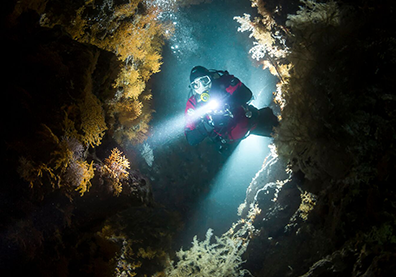This is the second level certification course for divers wishing to utilize a Closed Circuit Rebreather (CCR) for mixed gas diving using a Helitrox Diluent. The objective of the course is to train divers in the benefits, hazards and proper procedures for diving a CCR and to develop basic CCR diving skills, to a maximum of 45 metres/150 feet, using an air/nitrox/helium diluent for formal decompression diving. Students are permitted to utilize a diluent and bailout mix with no greater than a 20% helium content and no less than a 21% oxygen content, and are permitted to use up to 100% oxygen for decompression
What you can expect to learn:
The TDI Diving Rebreathers Student Manual and the manufacturer’s manual are mandatory for use during this course but instructors may use any additional text or materials that they feel help present these topics. The following topics must be covered during the course:
- History and evolution of rebreathers
- Comparison of open circuit, closed circuit and semi closed circuit rebreather systems and the benefits/problems with each
- Practical mechanics of the system
- Assembly and disassembly of the unit
- Layout and design of the unit
- Absorbent canister design and maintenance
- Proper packing of canister, in accordance with manufactures recommendations
- Breathing loop de-contamination procedures
- Manufacturer supported additional items (automatic diluent valve, etc.)
- Gas physiology
- Oxygen toxicity
- Nitrogen absorption
- CO2 toxicity
- Gas consumption
- Electronic and manual systems design and maintenance
- O2 metabolizing calculations
- Fuel cells
- Maintenance
- Replacement
- Manufacturing date
- System electronics functionality and calibration procedures
- Dive tables
- Constant partial pressure of oxygen (PPO2) theory
- Central nervous system (CNS) and awareness of oxygen tracking units (OTU)
- Dive computers
- Mix ajustable
- Constant PO2
- O2 integrated
- Dive planning
- Operational planning
- Gas requirements including bailout scenarios
- Oxygen limitations
- Nitrogen limitations
- Emergency procedures
- Use of B.A.D.D.A.S.S.
- Three H’s problems
- Flooded loop
- Cell warnings
- Battery warnings
- Bailout gas requirements
- Helium considerations
- Helium absorption and elimination
- Advantages of hyperoxic mixes for decompression
- Advantages of helium for bottom gas
- Hypoxia
- HPNS
- Effects on respiration
- Effects as an insulator
- Helium limitations
Open Water Skills:
- Pre dive checks
- Unit build-up
- Scrubber packing
- Positive and negative checks
- Verify diluent and O2 cylinder contents using O2 analyzer where appropriate
- Demonstrate correct pre dive planning procedures including
- Limits based on system performance
- Limits based on oxygen exposures at chosen PPO2 levels
- Limits based on nitrogen absorption at planned depth and PO2 set-point
- Thermal constraints
- Emergency procedures
- Mouthpiece familiarity drills
- Gas shutdowns and loss of gas
- Broken hoses
- Flooded absorbent canister
- CO2 breakthrough
- Semi-closed mode
- Low oxygen drills
- High oxygen drills
- Flooding loop
- Electronics and battery failure
- Properly execute the ascent procedures for an incapacitated CCR diver
- Use of BCD/suit and effective management of loop breathing volume for buoyancy control
- Stop at 3-6 metres/10 – 20 feet on descent for leak bubble check
- Electronics systems monitoring for PO2 levels (SETPOINT) and switching set-points
- Manual control of set-point if electronically controlled CCR is not used
- Use of lift-bag/delayed surface marker buoy and reel
- Proper execution of the dive within all pre-determined dive limits
- Constant-loop volume management
- Post dive clean of unit to avoid contamination and spread of disease
Czas trwania kursu 5 dni.
Cena szkolenia 1200 euro.
Cena szkolenia kurs indywidualny 1400 euro.
Zawiera: materiały szkoleniowe, certyfikat.




